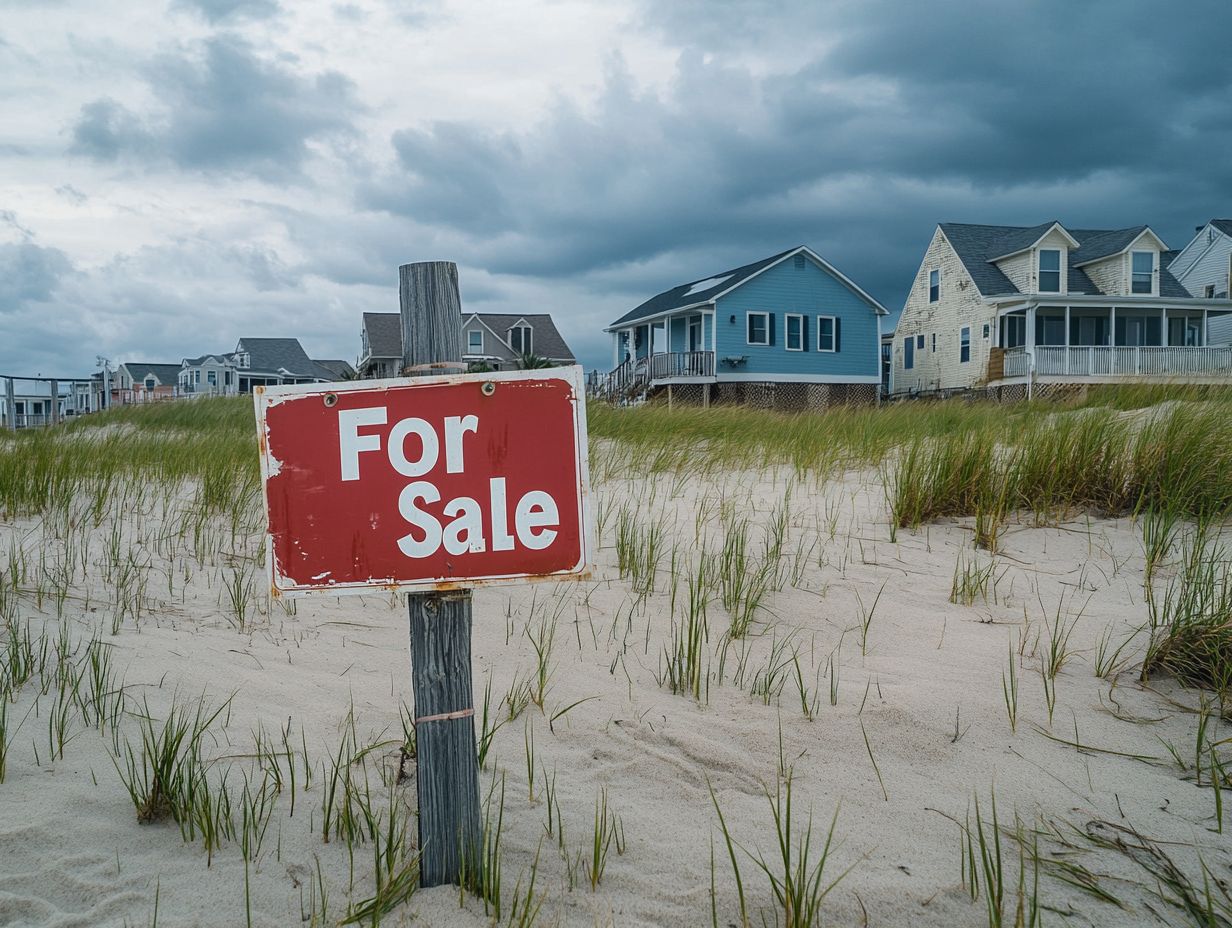How Climate Change Affects Real Estate Trends
Climate change is reshaping real estate. It s no longer a distant concern.
As environmental shifts influence demand and property values, you must navigate this new reality as both a buyer and an investor.
This article explores current trends driven by climate change, predicts future market shifts, and provides strategies for adaptation and resilience. Whether you re a homeowner, investor, or industry professional, understanding these dynamics is crucial for making smart decisions right now.
Contents
- Key Takeaways:
- Current Trends in Real Estate and Climate Change
- How Climate Change is Shaping the Future of Real Estate
- Mitigating the Effects of Climate Change in Real Estate
- Investing in Climate-Resilient Real Estate
- Frequently Asked Questions
- How does climate change affect real estate trends?
- What are some specific ways that climate change affects real estate trends?
- How does climate change impact the location of desirable real estate?
- What are some potential risks for real estate investors related to climate change?
- How can real estate professionals stay informed about climate change and its effects on the industry?
- What steps can be taken to mitigate the negative effects of climate change on real estate trends?
Key Takeaways:

Climate change is creating significant shifts in the real estate market, affecting demand and property values. The future of real estate will be shaped by climate change, with predicted changes in the market and industry. Mitigating the effects of climate change in real estate requires strategies for adaptation and resilience, while also presenting opportunities and challenges for investors.
Defining Climate Change and its Impact on Real Estate
Climate change presents a complex challenge that significantly influences the real estate market. It alters property values and creates new dynamics for your investment strategies.
You must navigate a landscape increasingly shaped by extreme weather events and rising sea levels. Properties in vulnerable locations risk depreciating values and attract scrutiny from insurers and lenders, complicating financing options.
There s a surge in demand for properties that incorporate energy-efficient designs and resilience features. This shift prompts you to reassess your investment portfolio. Government rules are evolving to tackle these risks, reshaping land use regulations and incentivizing green building practices.
Keep up with climate trends to stay ahead in the housing market! Staying informed about climatic trends and their impacts is essential for anyone involved in real estate.
Current Trends in Real Estate and Climate Change
Current trends show a clear connection between climate change and economic factors, such as rising insurance rates and fluctuating property values.
As challenges like sea level rise and flood risk gain prominence, you may reassess the viability of properties, especially those in coastal areas facing significant adaptation hurdles.
Shifts in Demand and Property Values
Demand for real estate is increasingly linked to your awareness of environmental risks, including flood threats and their impact on property values. As you, along with potential homeowners, seek sustainable properties, understanding how these factors influence market-based insurance becomes crucial, especially for low-income households striving to adapt.
In this evolving landscape, you become more discerning as a buyer, prioritizing homes that promise not just a lifestyle but also protection against environmental threats. This growing emphasis on sustainability is reshaping the real estate market.
As these shifts unfold, neighborhoods that proactively address climate change like improving drainage systems and creating green spaces tend to maintain higher property values. Consequently, you and other investors must navigate this intricate relationship between environmental sustainability and real estate viability, particularly in flood-prone areas.
How Climate Change is Shaping the Future of Real Estate

As climate change becomes integral to your understanding of real estate’s future, you ll notice how economic factors influence everything from housing bubbles to government policies.
The implications of these changes are extensive, compelling you to weave climate awareness into your investment research. In a market that demands adaptation and resilience, staying ahead of these challenges is essential for your success.
Predicted Changes in the Market and Industry
Predicted changes in the real estate market due to climate change are poised to reshape the landscape significantly. You can expect shifts in FEMA policies and a heightened emphasis on disaster recovery as communities adapt to the new realities of rising sea levels and more extreme weather events.
It’s essential for the industry to pivot, not just to mitigate risks but also to seize the opportunities that these challenges present. As urban planning evolves, market dynamics will certainly influence buyer preferences and property valuations.
Investors are likely to gravitate toward properties that demonstrate resilience against environmental changes, leading to a shift in construction standards and sustainability practices.
The integration of technology in monitoring environmental risks will play a crucial role in enhancing disaster recovery strategies, making properties in vulnerable areas less appealing.
Stakeholders must be agile and proactive to navigate these changes, talking about policies that prioritize long-term viability and community resilience in the face of an increasingly unpredictable climate.
Mitigating the Effects of Climate Change in Real Estate
Mitigating the effects of climate change in real estate is becoming an urgent priority for investors, especially as challenges like flooding and wildfire-prone areas present significant risks.
To safeguard investments and elevate property values, it s essential to focus on sustainable properties that provide resilience against these climate-related challenges. This proactive approach not only enhances risk management but also positions investors advantageously in an evolving market.
Strategies for Adaptation and Resilience
Strategies for adaptation and resilience in the face of climate change include a suite of innovative approaches designed to protect real estate investments, especially in flood-prone areas.
These strategies involve embracing sustainable properties and effective market-based insurance solutions to mitigate potential risks. To successfully navigate these challenges, investors can implement best practices like:
- Elevating structures
- Using permeable materials for landscaping
- Incorporating natural drainage systems
Encouraging the use of green roofs and rain gardens will enhance local biodiversity and reduce runoff. By investing in comprehensive insurance policies that cover climate-related damages, investors ensure that their properties are safeguarded against unforeseen events.
Leveraging technology, such as predictive analytics, helps investors forecast risks by analyzing data trends, allowing them to make informed decisions about risk assessments and future developments. This proactive approach to property resilience aligns seamlessly with evolving environmental conditions, positioning investors to thrive amidst uncertainty.
Investing in Climate-Resilient Real Estate

Investing in climate-resilient real estate opens doors but demands thorough research and a deep understanding of market dynamics.
As awareness of sustainability’s significance continues to rise, investors must adeptly navigate the complexities of adapting to climate change while also leveraging market-based insurance strategies to safeguard their assets.
Opportunities and Challenges for Investors
Investors in the realm of climate-resilient real estate face a distinctive mix of opportunities and challenges as they adapt to the realities of climate change. Pursuing sustainable properties opens the door to innovation but requires investors to navigate potential pitfalls and regulatory hurdles that may arise in this ever-evolving market.
As investors explore this sector, staying vigilant about prevailing market trends is crucial. Consumer preferences are increasingly leaning toward green buildings that emphasize energy efficiency and non-toxic environments.
Investors must pay close attention to ongoing regulations aimed at mitigating climate risks, as these will compel them to align their investments with sustainable practices.
The push for climate-resilient structures influences design and construction processes and grants a competitive edge to those who prioritize ecological stewardship. Ultimately, successfully navigating this landscape hinges on a strategic approach that balances financial viability with a steadfast commitment to sustainability.
Frequently Asked Questions
How does climate change affect real estate trends?
Climate change significantly impacts real estate trends, influencing the demand and value of properties based on environmental conditions. For a deeper insight, consider understanding seasonal trends in real estate.
Rising sea levels, extreme weather, and changing weather patterns can shift what buyers want. These changes lead to new real estate trends.
What are some specific ways that climate change affects real estate trends?

Climate change can change property insurance rates. Areas prone to extreme weather often face higher insurance costs.
It can also affect how new properties are built. Building rules may need updates to address climate risks.
How does climate change impact the location of desirable real estate?
Climate change can make some areas less desirable. Locations at risk for climate events may lose value.
For instance, coastal properties might face flooding and storm damage from rising sea levels. This could make them less appealing in the long run.
Investors may encounter risks like property damage and falling property values. They might also deal with higher insurance costs and stricter regulations.
Understanding and managing these risks is crucial for successful investments in a changing climate.
How can real estate professionals stay informed about climate change and its effects on the industry?
Real estate professionals can keep updated by reading news and reports on climate change. They can also attend seminars and collaborate with experts to understand its effects better.
What steps can be taken to mitigate the negative effects of climate change on real estate trends?
Investing in sustainable properties can help reduce negative impacts. Implementing eco-friendly building practices is also essential.
Professionals can work with local governments to address climate risks and plan for future developments.






